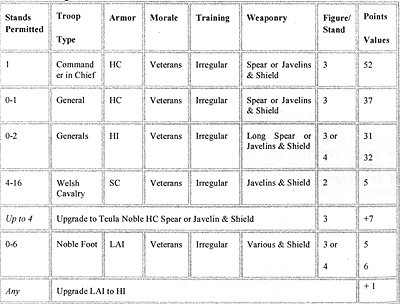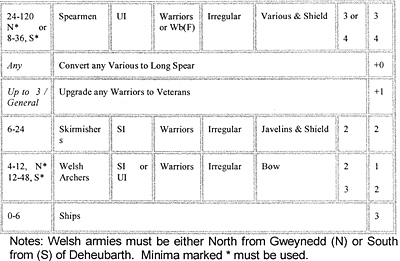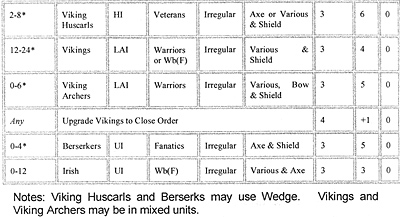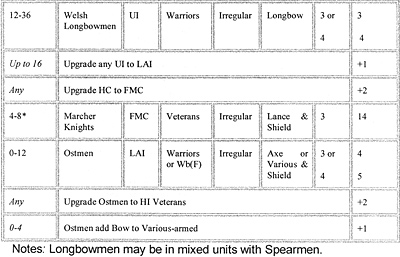The Welsh are what I would call a classic ‘underdog’ army. At first glance, they are easily overlooked with their mass of UI spearmen, SC and a mound of crummy SI archers. But careful cultivating of the list leads to a number of playable armies that are also easily morphed to and from other armies. In chronological order, they are two ‘Dark Ages’ lists, two feudal lists, and two Medieval lists, for a total of six distinct armies off of one list. Now THAT is cost effective!
 First, the two Dark Ages lists. In my mind, these revolve around filling the gap from army list #4, Arthurian Britons (ending in the 6th Century AD) and into the early years of the Welsh list (beginning 8th Century AD). So, I’m making an army that is a slide forward from the sub-roman British. It comes in two choices, North Welsh and South Welsh, and would focus on the following core choices:
First, the two Dark Ages lists. In my mind, these revolve around filling the gap from army list #4, Arthurian Britons (ending in the 6th Century AD) and into the early years of the Welsh list (beginning 8th Century AD). So, I’m making an army that is a slide forward from the sub-roman British. It comes in two choices, North Welsh and South Welsh, and would focus on the following core choices:
These are recommendations for both the North and South 500-point army. Take the CinC with Javelins, and upgrade four stands to teula HC with Javelins. These forces represent the remnants of Roman cambrogi heavy cavalry and their followers. Take 4-8 more stands of the veteran Welsh SC. Then take two other generals as HI and put them in two units with three stands of Noble Foot upgraded to HI with Long spears. You now have two units of four stands each, HI with long spears. You can use them as close order to represent the remnants of urban ‘Romanized’ Britons, or as loose order to represent veteran Welsh chieftains and their followers who raid on their neighbors. With the two HI, General with long spears, you’ll have two potent assault units. The veteran HC and SC with javelins give you mobility with some firepower.
 Here you have to make a choice between a North Welsh or South Welsh list. Both have plenty of spearmen and archers, but the potential to lean heavily towards a majority of one or the other. Choosing South Welsh allows you to retain 36 stands of spearmen while quadrupling the available archers to 48 stands, which seems the most flexible. But, if you really want an aggressive army, take a North Welsh army with a hundred or so stands of spearmen (at only 300 points!). You will be able to cover most of the table with a wall of troops.
Here you have to make a choice between a North Welsh or South Welsh list. Both have plenty of spearmen and archers, but the potential to lean heavily towards a majority of one or the other. Choosing South Welsh allows you to retain 36 stands of spearmen while quadrupling the available archers to 48 stands, which seems the most flexible. But, if you really want an aggressive army, take a North Welsh army with a hundred or so stands of spearmen (at only 300 points!). You will be able to cover most of the table with a wall of troops.
Again, you have the option to upgrade any spear units to close order and up to three per general to veterans. You may also switch any to warbands or long spears. Close order warriors or veterans with long spears in my mind are remnants of urbanized Romans, perhaps town militia or guards from the many Roman forts, certainly full-time soldiers paid by a chieftain or town. Warriors or warbands with various or long spears are priodaur or ‘freemen’ who are obligated to act as militia or
raiders depending on circumstances. There is nothing to say that you cannot have a mix of various spearmen in your army, each with a different task. Theoretically, you could have a unit of eight stands of close order veterans with long spears to drive off enemy cavalry, a dozen of warriors with long spears and a hundred stands of warbands with various or long spears to represent the mass of men.
Another option is with the many archers. They can be either SI or UI. A mix is probably best unless you know your opponent’s army. SI are effective against close-order foot, but vulnerable to loose-order foot and cavalry. UI bow are reasonable and cheap archers that can drive off enemy SI and SC, nip away at cavalry and lightly armored foot.
Finally, a few boats make a nice camp, or can transport an outflanking force. They also help with scouting. They are quite cheap, and I recommend them.
 With a core army in hand, let’s consider allies.
With a core army in hand, let’s consider allies.
Why have any allies? Well, figure and painting variety for one thing. Tactically, you should be picking allies who complement the choices you made with the Welsh. If you chose a lot of close-order spearmen, get a bunch of loose-order Vikings, or vice-versa. The Irish with various and axe are great rough-terrain attackers, but are vulnerable to shooting and cavalry. Of the two, the obvious choice are the ubiquitous Vikings, who are present in about ten other lists as allied forces not to mention their own lists and morphing them as Saxons, Islemen, etc. Personally, I suggest a strong force of close-order Vikings led by a unit or two of Huscarls and a unit of archers. This complements my usual choice of large numbers of loose-order Welsh spearmen.
The two units of Huscarls are tough, and the archers the best the army will have in this period. The regular Vikings with various are not that good, but as warband have some punch and as warriors can make a close-order shieldwall to hold an objective. The Irish are also in several other lists, including the Viking list, and can form the beginning of an army or be used as gall gael fanatics.
The two feudal lists are almost the same. Follow above recommendations with a few changes stated here. To take on the inevitable bunches of knights, take the second HC general and arm all six HC stands with spear. I would emphasize close-order warrior long spears if you want to play defensively with a shieldwall (and morph them into Scots), or loose order warband long spears if you want to fight aggressively. No matter what, you’ll need the long spears to deal with the cavalry. And historically, the Welsh were probably gravitating towards longer spears because of their encounters with Norman HC anyway. Take a lot of UI archers and one unit each of skirmishers with jav/sh or bow to represent ambushers and provide some shooting.
 Now we end up with the two final lists, the medieval lists of the North or South Welsh. I would continue the ideas of the feudal lists, but construct the infantry force around a strong group of HI veterans with long spears and a reserve of cheaper UI veterans with long spears. To them add a strong force of longbows.
Now we end up with the two final lists, the medieval lists of the North or South Welsh. I would continue the ideas of the feudal lists, but construct the infantry force around a strong group of HI veterans with long spears and a reserve of cheaper UI veterans with long spears. To them add a strong force of longbows.
Buy as many stands of longbows as you can afford. They are the cheapest longbows in the game at three or four points a stand. Again, if you plan to fight in the open, buy the infantry as close order. If you plan to fight in rough terrain, buy the infantry as loose order. When in doubt, buy a mix or loose-order to save points. The longbows should be close-order if you can afford it – they’ll shoot three ranks deep instead of two. Buy four to eight stands of Marcher Knights for punch, and upgrade the two generals and four stands of teula to FMC. If short on points, drop most of the SC and all the teula. You should end up with a force of about four to eight units of hard-hitting cavalry with some SC support, a bunch of longbows to weaken enemy foot or mounted before the knights charge, some tough spearmen to attack or defend, and some cheap spearmen to make a reserve, plug gaps, and clear rough terrain of pesky SI. For this army, you may want to favor the South Welsh list since it permits you to minimize the spearmen while only committing you to 12 stands of SI bowmen, a 36-point minimum of 20 stands of troops that are still pretty useful. This leaves you with more points to put into Marcher knights and longbows.
Building the Welsh Host
Back to Saga # 93 Table of Contents
Back to Saga List of Issues
Back to MagWeb Master Magazine List
© Copyright 2003 by Terry Gore
This article appears in MagWeb.com (Magazine Web) on the Internet World Wide Web.
Other articles from military history and related magazines are available at http://www.magweb.com